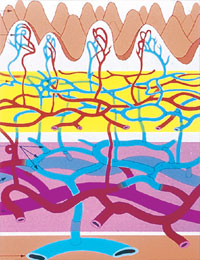
How does the vasculature of the dermis function in temperature control? Body temperature is regulated, in part, through control of dermal blood flow. Lowering body temperature is accomplished through increased blood flow in the vascular plexus in the high papillary dermis, allowing heat to be removed through radiation from the skin. The dermal vasculature is composed of a superficial and deep plexus of arterioles and venules that are interconnected by communicating vessels (Fig. 1-6). The incoming blood flow to the superficial capillary plexus in the upper dermis can be decreased by increased smooth muscle tone in the ascending arterioles, or it can be shunted directly from the arterioles to the venous channels in the deeper plexus systems via glomus bodies, which are modified arterioles surrounded by multiple layers of muscle cells. During cold temperatures, decreased papillary blood flow to the papillary dermis, in essence, shunts the blood away from the skin surface and decreases heat loss from the body. The hot flashes that typically occur in menopausal women are caused by an instability of this system. Periodic dilation of the skin capillaries allows increased blood flow to the skin, which is perceived as heat. |
© 2025 Skin Disease & Care | All Rights Reserved.